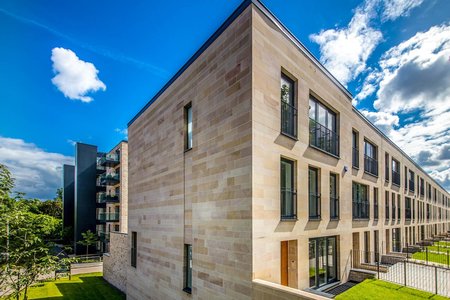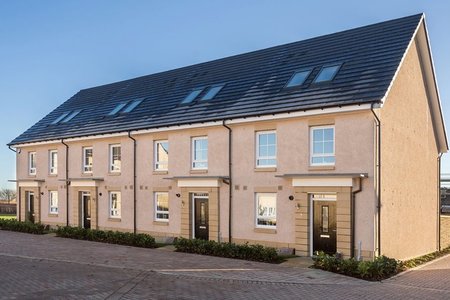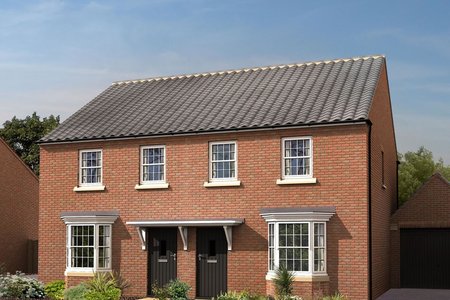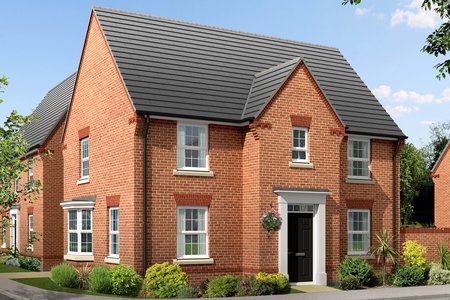When looking to buy a new home, there’s plenty to consider – including the size of the property. But what is considered a large house in the UK? Would detached or semi-detached be a better fit? What is the average floor space of a 4-bedroom house? To answer these questions and more, we’ve put together this guide on the different property types available to you – including each average house size in square footage, compared to the UK average floor area of 90m2[1].
1. Apartments
- Average UK house size: 656 sq. ft.
- Average number of bedrooms: 1 to 2
- Most popular with: Singletons, first-time buyers and older people
Apartments tend to be cheaper than buying a house in the same location. Ground floor apartments are 20% cheaper on average than apartments on the upper levels [2], while newer apartments often benefit from being open plan – making them feel more spacious. Thanks to the inclusion of features such as en-suites, balconies and communal areas, new builds are typically a more suitable choice than older builds.

Apartments are very common in urban areas. They’re usually leasehold, which means that you own what’s ‘within the walls’ – the freeholder owns and looks after the communal areas and anything outside your flat for you. Your apartment may come with a shared garden, gym, or concierge – the maintenance of which will usually be covered by a monthly or annual service charge. Your leasehold will last a set period of time (this is normally quite long-term and outlasts the time you’d live there), although you can apply to renew it if you want to.Does an apartment tick every box for you? Discover your dream one with us.
2. Bungalows
- Average UK house size: 828 sq. ft.
- Average number of bedrooms: 1 to 2
- Most popular with: Those requiring more accessibility
Bungalows can be detached or semi-detached, offering everything you need on one level – so they’re more accessible than two and three-storey homes. You typically pay more per square foot and, with a smaller average house size compared to other properties, traditional bungalows are often seen as outdated and cramped.Seeing as they’re not as popular nowadays, fewer are being built [3]. If you do want to buy one, though, you should consider a new build. They’re often in enviable locations and offer everything you could want from a home – spacious, modern living areas with equally spacious outdoor areas.Is a bungalow an ideal fit for you? Discover your dream home with us.
3. Terraced homes
- Average UK house size (smaller terraced home): 688 sq. ft.
- Average UK house size (larger terraced home): 1087 sq. ft.
- Average number of bedrooms: 2 to 3
- Most popular with: First-time buyers and young families
In terms of average house size, smaller terraced homes usually consist of two rooms upstairs and two rooms downstairs – complete with a small yard or garden. They may not include a utility room or any en suites, and will certainly have less storage space. Larger terraces have an extra room both downstairs and upstairs – sometimes with an additional room for storage, such as a utility room. Many traditional terraced homes have alleyways or passages running at the back of them, while stairs and hallways can be narrow inside. New-build terraced homes are very different, though; they have light and bright interiors, are situated on attractive developments (usually with gardens and driveways), and benefit from communal green spaces close by. New builds are also usually positioned on roads with a mix of semi-detached and detached homes, with no alleyways or passages. Does this one sound right for you? Discover your dream terraced home with us.
Many traditional terraced homes have alleyways or passages running at the back of them, while stairs and hallways can be narrow inside. New-build terraced homes are very different, though; they have light and bright interiors, are situated on attractive developments (usually with gardens and driveways), and benefit from communal green spaces close by. New builds are also usually positioned on roads with a mix of semi-detached and detached homes, with no alleyways or passages. Does this one sound right for you? Discover your dream terraced home with us.
4. Semi-detached homes
- Average UK house size: 1033 sq. ft.
- Average number of bedrooms: 3
- Most popular with: Families
It’s the most common type of family home and has remained that way for decades. With only one adjoining neighbour, semi-detached homes offer a balance between affordability and privacy. The average house size is greater than a small terraced home, giving you more indoor space and a larger garden/outdoor area. New builds have open-plan living areas, bathrooms designed to be both stylish and practical, and bedrooms that are more equally proportioned than older semi-detached homes. This makes them popular with growing families and those needing a home office as well as a spare bedroom.Is a semi-detached home your perfect match? Discover your dream home with us.
New builds have open-plan living areas, bathrooms designed to be both stylish and practical, and bedrooms that are more equally proportioned than older semi-detached homes. This makes them popular with growing families and those needing a home office as well as a spare bedroom.Is a semi-detached home your perfect match? Discover your dream home with us.
5. Detached homes
- Average UK house size: 1582 sq. ft.
- Average number of bedrooms: 4
- Most popular with: High earners
Thelargest (and often most desirable) properties, detached homes typically command the highest prices and offer the most privacy. A detached home usually features several reception rooms, bedrooms and bathrooms. With new builds, the downstairs space is often more open plan compared to older homes, with lots of natural light flooding into the property from the windows and doors. A lot of effort will have gone into creating the right flow from room to room, including plenty of space to entertain guests in the kitchen/dining area.Is this the one you’re looking for? Discover your dream detached home with us.
A detached home usually features several reception rooms, bedrooms and bathrooms. With new builds, the downstairs space is often more open plan compared to older homes, with lots of natural light flooding into the property from the windows and doors. A lot of effort will have gone into creating the right flow from room to room, including plenty of space to entertain guests in the kitchen/dining area.Is this the one you’re looking for? Discover your dream detached home with us.
The next step
Now that you know more about the average house size of each property type, you should have a better idea about which kind of home is right for you. If you’re interested in purchasing a new build, it’s worth making an appointment with a
new homes mortgage adviser (NHMA) as soon as possible. As well as letting you know how much you could potentially borrow, they’ll also be able to explain the different schemes to help you get moving – from
Low Deposit to
Help to Sell schemes. Why not
book an appointment with one of our Sales Advisers? They’ll be able to help you through the entire
buying process, from start to finish.








